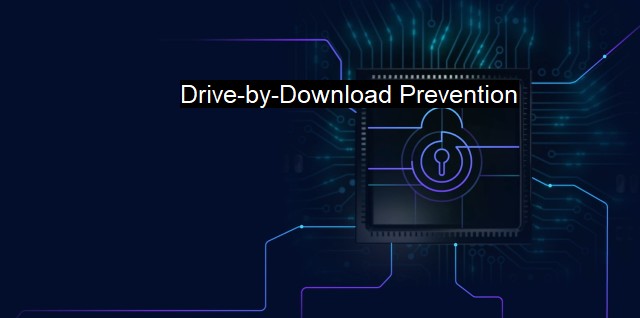What is Drive-by-Download Prevention?
Drive-By-Download Prevention (DBDP): Safeguarding Electronic Devices from Malware Attacks
Drive-by-download prevention refers to the tactics, measures, and strategies used to protect a computer system or network from unauthorized and unknowing downloads of potentially harmful software, such as viruses, worms, Trojan horses, and ransomware. This protection occurs when a user visits or interacts with a website and unintentional download takes place. The aim is to increase the level of security on a personal or network-based system and to prevent compromise or data loss that can result from a drive-by download attack. this is an essential part of maintaining a secure network and system environment.A menace to cybersecurity, drive-by-download attacks was primarily used as a tool to install malicious software (malware) onto a user's system without their notice or consent. Picture visiting a website and without moving a finger, malware downloads on your computer. Your device is suddenly part of a botnet, a group of interconnected compromised devices controlled by an external force, essentially threatening livelihoods, corporate structures, and government functions. Worse still, it does not need a user to perform an action as benign-looking websites or pop-up windows can be skewed to deploy these destructive payloads.
In a fast-evolving digital environment with massive access to information and resources through the internet, the need for drive-by download prevention is highly paramount. Traditional hackers would lure users into downloading harmful software by interaction, like clicking on a link or downloading a file. Over time, malicious cyber actors have learnt to play their game stealthily and shrewdly. Once a website has been manipulated with strategic coding, users' systems get infiltrated without requiring them to download or click anything in particular. It occurs in the blink of an eye when a user merely visits a compromised website – this happens in what is known as a drive-by download attack.
Having grasped what a drive-by download is and the encompassing threats which follow suit, comprehending the role of cybersecurity and antivirus programs in preventing such malware attacks will unveil the importance of drive-by download prevention.
Antivirus programs are like a shield, they work to counter the malicious activities prevalent in the digital world. They scan files, web pages, software, many of which are on a real-time basis, spotting and nullifying the probable threats before they could wreak havoc. Some antivirus programs offer internet security suites that provide complete protection mechanisms, including software security updates, spam filters, safe browsing features, and interactive firewalls, alongside traditional virus and malware threat counteraction features.
Cybersecurity endorses an organizations' establishment and maintenance of protective measures which defend computing resources, a network's or internet's integrity, data confidentialities, and user's personal information from cyber threats. It extends its realm to protect against drive-by download threats, which are often hard to spot due to their subtle nature. Cybersecurity leverages tools to ensure secure coding, to continuously scan vulnerabilities, and of course, to educate users and enterprises about potential threats and protective measures.
Totally combating the pernicious attacks of drive-by downloads isn’t a no-brainer and it requires vigilance, an understanding of the risk factors and the implementation of effective preventative measures. Popular prevention practices include keeping all software updated to the latest versions since they have updated security patches, constant running and updating of a reputable security or antivirus program, and educating users on the potential threats and the nature of suspicious activity.
By creating a comprehensive defensive layer using a reputed antivirus program, frequently updating software, promoting awareness, and saying a strict no-no to clicking on links from unknown sources, users can keep their devices fortified against drive-by download attacks, truly endorsing the significance of drive-by download prevention. Curbing drive-by downloads not only mitigates system vulnerabilities but also contributes to overall cyber resilience, thereby fortifying not just individual applications but collective cyber networks on the whole.

Drive-by-Download Prevention FAQs
What is drive-by-download and why should I be concerned about it?
Drive-by-download is a type of attack where malware is downloaded onto your computer without your knowledge or consent, often through clicking on a link or visiting a website. It can lead to serious cybersecurity risks such as data theft, ransomware, and financial loss.How can I prevent drive-by-download attacks?
To prevent drive-by-download attacks, you should use anti-virus software, keep your operating system and web browser up-to-date with the latest security patches, avoid clicking on suspicious links and pop-ups, and limit your exposure to risky websites.What are some common signs of a drive-by-download attack?
Some common signs of drive-by-download attacks include slow performance, pop-up ads, browser redirects, unfamiliar icons on your desktop, and unauthorized changes to your computer's settings. If you suspect that your computer has been compromised, you should immediately run a virus scan and seek professional help if needed.Can my mobile device be affected by drive-by-download attacks?
Yes, mobile devices such as smartphones and tablets can also be vulnerable to drive-by-download attacks. You should take similar precautions to protect your mobile devices, such as using anti-virus software and avoiding suspicious links and downloads.| | A | | | B | | | C | | | D | | | E | | | F | | | G | | | H | | | I | | | J | | | K | | | L | | | M | |
| | N | | | O | | | P | | | Q | | | R | | | S | | | T | | | U | | | V | | | W | | | X | | | Y | | | Z | |
| | 1 | | | 2 | | | 3 | | | 4 | | | 7 | | | 8 | | |||||||